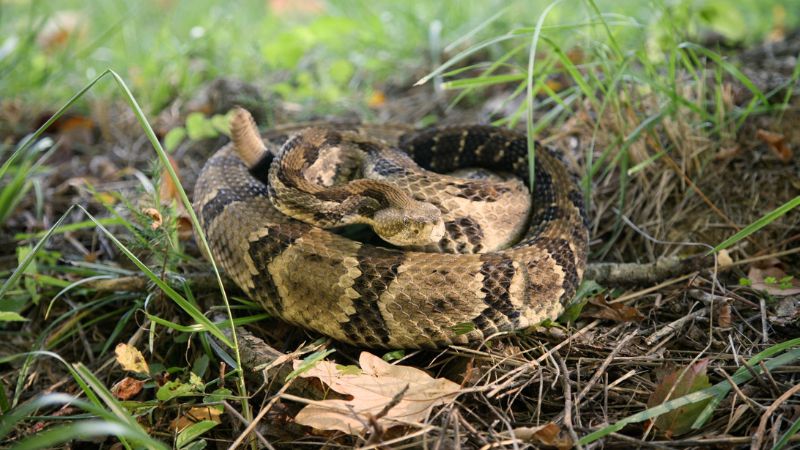Timber rattlesnakes are one of the most widespread snakes across Eastern United States. Although bites from timber rattlesnakes are rarely fatal, it is still important to know what to do when encountering them.
So, how to get rid of timber rattlesnakes? Call a professional immediately. Don’t attempt to handle the snake yourself or else it will lash out and bite you. Once they are removed from the premises, prevent them from coming back by snake-proofing your property.
To know more about timber rattlesnakes, how to properly identify them, and how to effectively snake-proof your property, simply read further this article!
What Are Timber Rattlesnakes?

Also called Canebrake rattlesnakes, Timber rattlesnakes are large, heavy-bodied pit vipers that are gray in color with a stripe across their body. They have a distinct dark pattern on their back and sides that helps them camouflage.
Timber rattlesnakes are one of the most common rattlesnakes found across the eastern United States. Due to human-induced habitat destruction, their populations are steadily decreasing in their geographic range.
What Do Timber Rattlesnakes Like?
Timber rattlesnakes like trees which come as no shock that they are excellent climbers. In fact, they are known to scale trees of up to 80 feet in height. They also like basking in the sun on bluffs and rock ledges, particularly during the spring and autumn seasons.
What Do Timber Rattlesnakes Eat?
They mainly eat rodents such as rats, mice, shrews, squirrels, and chipmunks. But they also feed on lizards, birds, and amphibians. Timber rattlesnakes capture prey by waiting under cover, abruptly striking the unsuspecting animal, biting them, then injecting their venom.
Where Do Timber Rattlesnakes Live?
Timber rattlesnakes live in a diverse range of habitats. This includes forests, agricultural fields, farmlands, lowland cane thickets, and floodplains. Populations found in higher elevations are called timber rattlers while those on lowland areas are referred to as canebrakes.
How Long Does Timber Rattlesnakes Live?
They have a lifespan of 16 to 22 years in the wild and up to 37 years in captivity. However, this longevity depends on their environmental conditions, quality of care and maintenance, and intensity of predation.
How Big Will Timber Rattlesnakes Get?
Timber rattlesnakes can grow 35 to 60 inches long and weigh around 500 grams to 1 kilogram. The longest individual, however, grew up to 75 inches. Males are usually longer and heavier than the females.
What Is the Behavior of Timber Rattlesnakes?
Timber rattlesnakes are solitary creatures, preferring to hunt and hibernate alone. They are primarily diurnal but become crepuscular or nocturnal during the summer.
Are Timber Rattlesnakes Venomous?
Yes. Their venom is hemotoxic, which destroys red blood cells, subsequently affecting cell tissues. If left untreated, timber rattlesnake venom can lead to internal bleeding, heart attacks, and loss of limbs.
Related: How to Get Rid of Kingsnakes | Easy & Humane!
How Dangerous Are Timber Rattlesnakes?

Generally, timber rattlesnakes are shy vipers. When encountering humans, they usually lie motionless as they try hard to avoid being detected. Once they’re disturbed, they either escape quickly or coil in an S-shape and vibrate their rattles.
Why Are Timber Rattlesnakes Attracted to Your House?
They may be looking for a warm place to say during harsh weather conditions or are currently on the lookout for more food. Your house may just be the perfect location for these reasons.
Signs of Timber Rattlesnakes
Look for these indicative signs that you may have a rattlesnake in the premises:
- Shed snake skin
- Fecal droppings
- Hissing noises in walls, vents, and other structures
- Slither tracks or trails
Related: How to Identify Snake Droppings? | Identification and Guide
How to Get Rid of Timber Rattlesnakes?

The safest and most effective way of getting rid of timber rattlesnakes is to call a professional, or local wildlife authorities. Don’t attempt to handle these reptiles as they may lash out and bite you.
Related: How to Get Rid of Cottonmouth Snakes? | Effective Techniques and Safety Tips
How to Prevent Timber Rattlesnakes From Getting Into Your House?
After letting professionals remove and relocate the snakes far away from the premises, snake-proof your property so they won’t ever come back. Here’s how:
- Regularly mow or trim vegetation. For grass, make sure they’re mowed down as close to the ground as possible. For trees and shrubs, make sure there is a 2 to 3 feet space under them to keep snakes from hiding.
- Store wood and other debris properly. Keep them in a warehouse or other storage areas that are inaccessible to the snakes as these provide decent shelter for the reptiles.
- Seal any existing and potential openings. This includes cracks and crevices found in and around your home. Install door sweeps, vent screens, and pool covers when necessary.
- Remove food sources. Do so by controlling rodent populations. This instantly makes your property less attractive for rattlesnakes. Additionally, clean up any spilled pet food or bird feed.
Related: How to Get Rid of Black Rat Snakes? | Effective, Safe, and Humane Solutions
List of Sources
Falk, A. (n.d.). Timber rattlesnake: (atricaudatus).
Messmer, T. (2018). 12 Ways to Stop Snakes From Slithering Into Your Yard.
Missouri Department of Conservation. (n.d.). Timber Rattlesnake.
Owen, S. (n.d.). Avoiding Snake Encounters.
Smithsonian’s National Zoo & Conservation Biology Institute. (n.d.). Timber Rattlesnake.
Taylor, R. (n.d.). Canebrake / Timber Rattlesnake (Crotalus horridus) – Venomous.
- How to Get Rid of Turtles | Proven Long-Term Solutions! - August 26, 2023
- How to Get Rid of Kingsnakes | Easy & Humane! - August 26, 2023
- How to Get Rid of Northern Water Snakes | Best Solutions and Preventative Measures! - August 19, 2023

